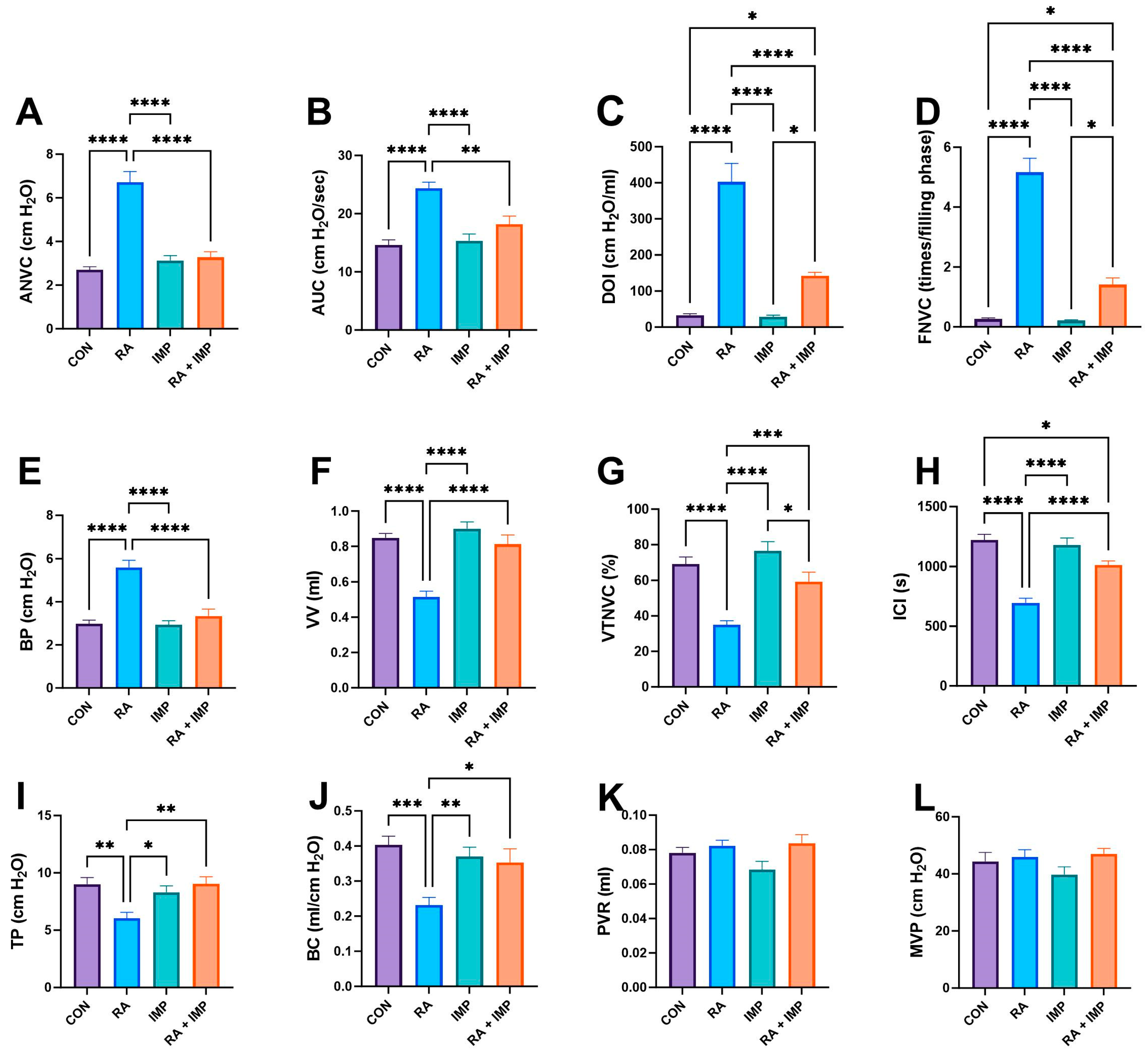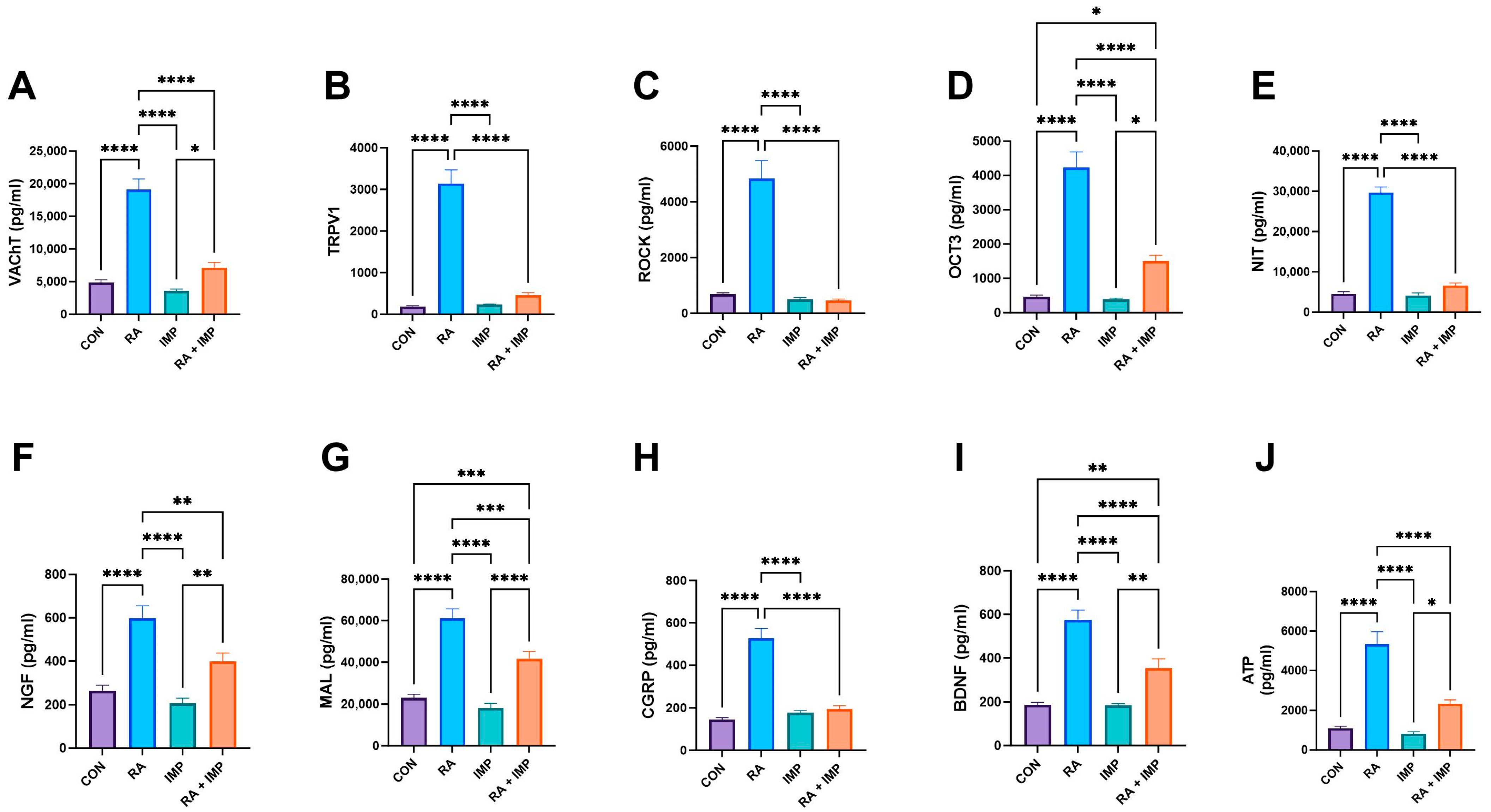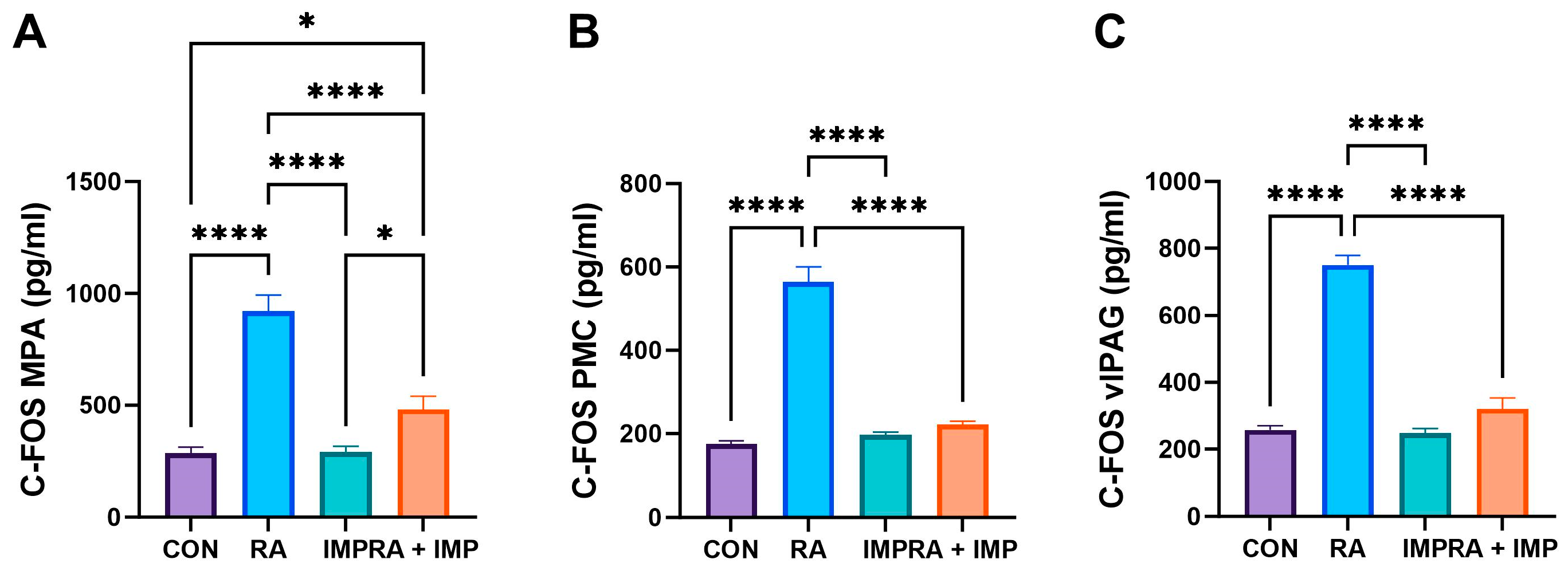The Assessment of the Efficacy of Imperatorin in Reducing Overactive Bladder Symptoms
Abstract
:1. Introduction
2. Results
2.1. Characteristics of Cardiovascular and Diuresis Parameters in Experimental Groups
2.2. The Influence of Imperatorin on Retinyl Acetate-Induced Changes in Cystometric Parameters
2.3. Selected Biochemical Analysis
2.4. Analysis of c-Fos—A Neuronal Activity
3. Discussion
4. Materials and Methods
4.1. Animals
4.2. Study Design
4.3. Drugs Used in the Study
4.4. Surgical Procedures
4.5. Conscious Cystometry
4.6. Bladder Blood Flow (BBF)
4.7. The Assessment of Cardiovascular Parameters and Diuresis
4.8. Determining the Expression Levels of c-Fos in Central Micturition Areas
4.9. Biochemical Analyses
4.10. Statistical Analysis
Author Contributions
Funding
Institutional Review Board Statement
Informed Consent Statement
Data Availability Statement
Conflicts of Interest
Abbreviations
| ANVC | nonvoiding contraction amplitude (cm H2O) |
| ATP | adenosine triphosphate (pg/mL) |
| AUC | area under the pressure curve (cm H2O/s) |
| BBF | bladder blood flow (colour scale) |
| BC | bladder compliance (mL/cm H2O) |
| BDNF | brain-derived neurotrophic factor (pg/mL) |
| BP | basal pressure (cm H2O) |
| c-Fos | AP-1 transcription factor subunit (pg/mL) |
| CGRP | calcitonin gene-related peptide (pg/mL) |
| DO | detrusor overactivity |
| DOI | detrusor overactivity index (cm H2O/mL) |
| FNVC | nonvoiding contraction frequency (times/filling phase) |
| HR | heart rate (beats/min) |
| ICI | intercontraction interval (s) |
| MAL | malondialdehyde (pg/mL) |
| MAP | arterial pressure (mm Hg) |
| MPA | medial preoptic area |
| MVP | micturition voiding pressure (cm H2O) |
| NGF | nerve growth factor (pg/mL) |
| NIT | 3-nitrotyrosine (pg/mL) |
| OAB | overactive bladder syndrome |
| OCT3 | organic cation transporter 3 (pg/mL) |
| PMC | pontine micturition center |
| PVR | post-void residual (mL) |
| ROCK | Rho kinase (pg/mL) |
| TP | threshold pressure (cm H2O) |
| TRPV1 | transient receptor potential cation channel subfamily V, member 1 |
| UP | urine production (mL/day) |
| UT | urothelium thickness (µm) |
| VAChT | vesicular acetylcholine transporter (pg/mL) |
| vlPAG | ventrolateral periaqueductal gray |
| VTNVC | volume threshold to elicit NVC (%) |
| VV | voided volume (mL) |
References
- Wróbel, A.; Juszczak, K.; Adamowicz, J.; Drewa, T.; Dudka, J. The Influence of Potentilla Chinensis Aqueous Extract on Urinary Bladder Function in Retinyl Acetate-Induced Detrusor Overactivity in Rats. Biomed. Pharmacother. 2020, 132, 110861. [Google Scholar] [CrossRef] [PubMed]
- Wróbel, A.; Serefko, A.; Szopa, A.; Poleszak, E. Stimulation of Atypical Cannabinoid Receptor GPR55 Abolishes the Symptoms of Detrusor Overactivity in Spontaneously Hypertensive Rats. Eur. J. Pharm. Sci. 2020, 150, 105329. [Google Scholar] [CrossRef] [PubMed]
- Wróbel, A.; Szopa, A.; Serefko, A.; Poleszak, E. A Novel Alternative in the Treatment of Detrusor Overactivity? In Vivo Activity of O-1602, the Newly Synthesized Agonist of GPR55 and GPR18 Cannabinoid Receptors. Molecules 2020, 25, 1384. [Google Scholar] [CrossRef]
- Wróbel, A.; Serefko, A.; Szopa, A.; Poleszak, E. Asiatic Acid, a Natural Compound That Exerts Beneficial Effects on the Cystometric and Biochemical Parameters in the Retinyl Acetate-Induced Model of Detrusor Overactivity. Front. Pharmacol. 2021, 11, 574108. [Google Scholar] [CrossRef] [PubMed]
- Kozioł, E.; Skalicka-Woźniak, K. Imperatorin–Pharmacological Meaning and Analytical Clues: Profound Investigation. Phytochem. Rev. 2016, 15, 627–649. [Google Scholar] [CrossRef]
- Chen, J.; Carmel, M.E. Quality, Value, and Efficacy of Alternative Medicine in the Treatment of Overactive Bladder. Curr. Bl. Dysfunct. Rep. 2023, 18, 139–146. [Google Scholar] [CrossRef]
- Lay, H.L.; Chen, C.C.; Huang, S.C.; Cham, T.M.; Wu, T.S.; Lin, I.H. Simultaneous Analysis of Nine Components in Patch Preparations of Ru-Yi-Jin-Huang-San by High-Performance Liquid Chromatography. J. Nat. Med. 2010, 64, 194–202. [Google Scholar] [CrossRef]
- Tada, Y.; Shikishima, Y.; Takaishi, Y.; Shibata, H.; Higuti, T.; Honda, G.; Ito, M.; Takeda, Y.; Kodzhimatov, O.K.; Ashurmetov, O.; et al. Coumarins and γ-Pyrone Derivatives from Prangos Pabularia: Antibacterial Activity and Inhibition of Cytokine Release. Phytochemistry 2002, 59, 649–654. [Google Scholar] [CrossRef]
- Mishra, B.B.; Singh, D.D.; Kishore, N.; Tiwari, V.K.; Tripathi, V. Antifungal Constituents Isolated from the Seeds of Aegle Marmelos. Phytochemistry 2010, 71, 230–234. [Google Scholar] [CrossRef]
- Yang, W.; Ye, M.; Liu, M.; Kong, D.; Shi, R.; Shi, X.; Zhang, K.; Wang, Q.; Lantong, Z. A Practical Strategy for the Characterization of Coumarins in Radix Glehniae by Liquid Chromatography Coupled with Triple Quadrupole-Linear Ion Trap Mass Spectrometry. J. Chromatogr. A 2010, 1217, 4587–4600. [Google Scholar] [CrossRef]
- Mata, R.; Macías, M.L.; Rojas, I.S.; Lotina-Hennsen, B.; Toscano, R.A.; Anaya, A.L. Phytotoxic Compounds from Esenbeckia Yaxhoob. Phytochemistry 1998, 49, 441–449. [Google Scholar] [CrossRef]
- Feng, C.; Cai, Y.L.; Ruan, J.L. Simultaneous Determination of 10 Active Components in Traditional Chinese Medicine “YIGONG” Capsule by RP-HPLC-DAD. J. Pharm. Biomed. Anal. 2008, 47, 442–447. [Google Scholar] [CrossRef] [PubMed]
- Xu, G.H.; Kim, J.A.; Kim, S.Y.; Ryu, J.C.; Kim, Y.S.; Jung, S.H.; Kim, M.K.; Lee, S.H. Terpenoids and Coumarins Isolated from the Fruits of Poncirus Trifoliata. Chem. Pharm. Bull. 2008, 56, 839–842. [Google Scholar] [CrossRef] [PubMed]
- Vogl, S.; Zehl, M.; Picker, P.; Urban, E.; Wawrosch, C.; Reznicek, G.; Saukel, J.; Kopp, B. Identification and Quantification of Coumarins in Peucedanum Ostruthium (L.) Koch by HPLC-DAD and HPLC-DAD-MS. J. Agric. Food Chem. 2011, 59, 4371–4377. [Google Scholar] [CrossRef]
- Sigurdsson, S.; Gudbjarnason, S. Effect of Oral Imperatorin on Memory in Mice. Biochem. Biophys. Res. Commun. 2013, 441, 318–320. [Google Scholar] [CrossRef] [PubMed]
- Sarkhail, P. Traditional Uses, Phytochemistry and Pharmacological Properties of the Genus Peucedanum: A Review. J. Ethnopharmacol. 2014, 156, 235–270. [Google Scholar] [PubMed]
- Liang, X.L.; Ji, M.M.; Liao, Z.G.; Zhao, G.W.; Tang, X.L.; Dong, W. Chemosensitizing Effect and Mechanism of Imperatorin on the Anti-Tumor Activity of Doxorubicin in Tumor Cells and Transplantation Tumor Model. Korean J. Physiol. Pharmacol. 2022, 26, 145–155. [Google Scholar] [CrossRef]
- Chowdhury, A.A.; Gawali, N.B.; Shinde, P.; Munshi, R.; Juvekar, A.R. Imperatorin Ameliorates Lipopolysaccharide Induced Memory Deficit by Mitigating Proinflammatory Cytokines, Oxidative Stress and Modulating Brain-Derived Neurotropic Factor. Cytokine 2018, 110, 78–86. [Google Scholar] [CrossRef]
- Purves, D.; Augustine, G.J. Neurscience, 3rd ed.; Sinauer Associates, Inc.: Sunderland, MA, USA, 2004; ISBN 9780128160763. [Google Scholar]
- Lin, W.; Chen, G.; Mao, Y.; Ma, X.; Zhou, J.; Yu, X.; Wang, C.; Liu, M. Imperatorin Inhibits Proliferation, Migration, and Inflammation via Blocking the NF-ΚB and MAPK Pathways in Rheumatoid Fibroblast-like Synoviocytes. ACS Omega 2022, 7, 29868–29876. [Google Scholar] [CrossRef]
- Karakaya, S.; Koca, M.; Yılmaz, S.V.; Yıldırım, K.; Pınar, N.M.; Demirci, B.; Brestic, M.; Sytar, O. Molecular Docking Studies of Coumarins Isolated from Extracts and Essential Oils of Zosima Absinthifolia Link as Potential Inhibitors for Alzheimer’s Disease. Molecules 2019, 24, 722. [Google Scholar] [CrossRef]
- Varier, K.M.; Thangarajan, S.; Chinnasamy, A. Effect of Imperatorin in Neuropathology of Parkinson’s Disease: An In Silico Study. Int. J. Pharm. Clin. Res. 2017, 9, 599–609. [Google Scholar] [CrossRef]
- Chughtai, B.; Kavaler, E.; Lee, R.; Te, A.; Kaplan, S.A.; Lowe, F. Use of Herbal Supplements for Overactive Bladder. Rev. Urol. 2013, 15, 93. [Google Scholar] [PubMed]
- Yagi, H.; Sato, R.; Nishio, K.; Arai, G.; Soh, S.; Okada, H. Clinical Efficacy and Tolerability of Two Japanese Traditional Herbal Medicines, Hachimi-Jio-Gan and Gosha-Jinki-Gan, for Lower Urinary Tract Symptoms with Cold Sensitivity. J. Tradit. Complement. Med. 2015, 5, 258–261. [Google Scholar] [CrossRef]
- Szewczyk, K.; Kock, A.B. Analytical Methods for Isolation, Separation and Identification of Selected Furanocoumarins in Plant Material. In Phytochemicals—A Global Perspective of Their Role in Nutrition and Health; IntechOpen: London, UK, 2012. [Google Scholar]
- Deng, M.; Xie, L.; Zhong, L.; Liao, Y.; Liu, L.; Li, X. Imperatorin: A Review of Its Pharmacology, Toxicity and Pharmacokinetics. Eur. J. Pharmacol. 2020, 879, 173124. [Google Scholar] [CrossRef] [PubMed]
- Ekor, M. The Growing Use of Herbal Medicines: Issues Relating to Adverse Reactions and Challenges in Monitoring Safety. Front. Pharmacol. 2014, 4, 177. [Google Scholar] [CrossRef] [PubMed]
- Huang, G.J.; Deng, J.S.; Liao, J.C.; Hou, W.C.; Wang, S.Y.; Sung, P.J.; Kuo, Y.H. Inducible Nitric Oxide Synthase and Cyclooxygenase-2 Participate in Anti-Inflammatory Activity of Imperatorin from Glehnia Littoralis. J. Agric. Food Chem. 2012, 60, 1673–1681. [Google Scholar] [CrossRef]
- Zheng, Y.M.; Lu, A.X.; Shen, J.Z.; Kwok, A.H.Y.; Ho, W.S. Imperatorin Exhibits Anticancer Activities in Human Colon Cancer Cells via the Caspase Cascade. Oncol. Rep. 2016, 35, 1995–2002. [Google Scholar] [CrossRef]
- Kowalczyk, J.; Nakos-Bimpos, M.; Polissidis, A.; Dalla, C.; Kokras, N.; Skalicka-Woźniak, K.; Budzyńska, B. Imperatorin Influences Depressive-like Behaviors: A Preclinical Study on Behavioral and Neurochemical Sex Differences. Molecules 2022, 27, 11797. [Google Scholar] [CrossRef]
- Lee, E.; Choi, S.Y.; Yang, J.H.; Lee, Y.J. Preventive Effects of Imperatorin on Perfluorohexanesulfonateinduced Neuronal Apoptosis via Inhibition of Intracellular Calcium-Mediated ERK Pathway. Korean J. Physiol. Pharmacol. 2016, 20, 399–406. [Google Scholar] [CrossRef]
- Nasser, M.I.; Zhu, S.; Hu, H.; Huang, H.; Guo, M.; Zhu, P. Effects of Imperatorin in the Cardiovascular System and Cancer. Biomed. Pharmacother. 2019, 120, 109401. [Google Scholar]
- Zhang, M.; Wen, Y.; Liang, P.; Yang, C.; Tu, H.; Wei, J.; Du, J.; Zhan, T.; Liang, S.; Li, G.; et al. Imperatorin Improves Obesity-Induced Cardiac Sympathetic Nerve Injury Mediated by P2X4 Receptor in Stellate Sympathetic Ganglion. Int. J. Mol. Sci. 2023, 24, 783. [Google Scholar] [CrossRef] [PubMed]
- Zhang, Y.; Cao, Y.; Zhan, Y.; Duan, H.; He, L. Furanocoumarins-Imperatorin Inhibits Myocardial Hypertrophy Both in Vitro and in Vivo. Fitoterapia 2010, 81, 1188–1195. [Google Scholar] [CrossRef] [PubMed]
- Wróbel, A.; Łańcut, M.; Rechberger, T. A New Model of Detrusor Overactivity in Conscious Rats Induced by Retinyl Acetate Instillation. J. Pharmacol. Toxicol. Methods 2015, 74, 7–16. [Google Scholar] [CrossRef] [PubMed]
- Pan, F.; Liu, D.; Han, X.M.; Li, W.C.; Pang, Z.L.; Li, B.; Zhang, X.P.; Xiao, Y.J.; Zeng, F.Q. Urodynamic Investigation of Cyclophosphamide-Induced Overactive Bladder in Conscious Rats. Chin. Med. J. 2012, 125, 321–325. [Google Scholar] [CrossRef]
- Behr-Roussel, D.; Oger, S.; Pignol, B.; Pham, E.; Le Maux, A.; Chabrier, P.E.; Caisey, S.; Compagnie, S.; Picaut, P.; Bernabé, J.; et al. Minimal Effective Dose of Dysport and Botox in a Rat Model of Neurogenic Detrusor Overactivity. Eur. Urol. 2012, 61, 1054–1061. [Google Scholar] [CrossRef] [PubMed]
- Zhang, X.; Li, W.; Abudureheman, A.; Cheng, T.; Peng, P. Imperatorin Possesses Notable Anti-Inflammatory Activity in Vitro and in Vivo through Inhibition of the NF-ΚB Pathway. Mol. Med. Rep. 2017, 16, 8619–8626. [Google Scholar] [CrossRef]
- Zhang, Y.; Cao, Y.; Duan, H.; Wang, H.; He, L. Imperatorin Prevents Cardiac Hypertrophy and the Transition to Heart Failure via NO-Dependent Mechanisms in Mice. Fitoterapia 2012, 83, 60–66. [Google Scholar] [CrossRef]
- Nomiya, M.; Andersson, K.E.; Yamaguchi, O. Chronic Bladder Ischemia and Oxidative Stress: New Pharmacotherapeutic Targets for Lower Urinary Tract Symptoms. Int. J. Urol. 2015, 22, 40–46. [Google Scholar] [CrossRef]
- Mendel, M.; Skalicka-Woźniak, K.; Chłopecka, M.; Dziekan, N. Effect of Imperatorin on the Spontaneous Motor Activity of Rat Isolated Jejunum Strips. Evid. Based Complement. Altern. Med. 2015, 2015, 614849. [Google Scholar] [CrossRef]
- Abad, M.J.; de las Heras, B.; Silván, A.M.; Pascual, R.; Bermejo, P.; Rodriguez, B.; Villar, A.M. Effects of Furocoumarins from Cachrys Trifida on Some Macrophage Functions. J. Pharm. Pharmacol. 2010, 53, 1163–1168. [Google Scholar] [CrossRef]
- de Smet, P.A.G.M.; Keller, K.; Hänsel, R.; Chandler, R.C. (Eds.) Adverse Effects of Herbal Drugs, 1st ed.; Springer: Berlin/Heidelberg, Germany, 1992; ISBN 978-3-540-60181-4. [Google Scholar]
- Lips, K.S.; Wunsch, J.; Zarghooni, S.; Bschleipfer, T.; Schukowski, K.; Weidner, W.; Wessler, I.; Schwantes, U.; Koepsell, H.; Kummer, W. Acetylcholine and Molecular Components of Its Synthesis and Release Machinery in the Urothelium. Eur. Urol. 2007, 51, 1042–1053. [Google Scholar] [CrossRef] [PubMed]
- Al-Ghazo, M.A.; Ghalayini, I.F.; Al-Azab, R.; Hani, O.B.; Matani, Y.S.; Haddad, Y. Urodynamic Detrusor Overactivity in Patients with Overactive Bladder Symptoms. Int. Neurourol. J. 2011, 15, 48–54. [Google Scholar] [CrossRef] [PubMed]
- Lee, M.H.; Kim, H.; Lim, B.V.; Chang, H.K.; Lee, T.H.; Jang, M.H.; Shin, M.C.; Lee, J.; Shin, M.S.; Kim, C.J. Naloxone Potentiates Treadmill Running-Induced Increase in c-Fos Expression in Rat Hippocampus. Life Sci. 2003, 73, 3139–3147. [Google Scholar] [CrossRef] [PubMed]
- Rao, Y.; Gao, Z.; Li, X.; Li, X.; Li, J.; Liang, S.; Li, D.; Zhai, J.; Yan, J.; Yao, J.; et al. Ventrolateral Periaqueductal Gray Neurons Are Active During Urination. Front. Cell. Neurosci. 2022, 16, 865186. [Google Scholar] [CrossRef]
- Kim, H.Y.; Lee, K.H.; Lee, D.G.; Lee, S. The Protective Activity of Linear Furanocoumarins from Angelica Dahurica against Glucose-Mediated Protein Damage. J. Korean Soc. Appl. Biol. Chem. 2012, 55, 355–358. [Google Scholar] [CrossRef]
- Wróbel, A.; Rechberger, T. The Influence of Rho-Kinase Inhibition on Acetic Acid-Induced Detrusor Overactivity. Neurourol. Urodyn. 2017, 36, 263–270. [Google Scholar] [CrossRef]
- Budzynska, B.; Boguszewska-Czubara, A.; Kruk-Slomka, M.; Skalicka-Wozniak, K.; Michalak, A.; Musik, I.; Biala, G. Effects of Imperatorin on Scopolamine-Induced Cognitive Impairment and Oxidative Stress in Mice. Psychopharmacology 2015, 232, 931–942. [Google Scholar] [CrossRef]
- Budzynska, B.; Kruk-Slomka, M.; Skalicka-Wozniak, K.; Biala, G.; Glowniak, K. The Effects of Imperatorin on Anxiety and Memory-Related Behavior in Male Swiss Mice. Exp. Clin. Psychopharmacol. 2012, 20, 325–332. [Google Scholar] [CrossRef]
- Wróbel, A.; Rechberger, T. The Effect of Combined Treatment with a β(3) AR Agonist and a ROCK Inhibitor on Detrusor Overactivity. Neurourol. Urodyn. 2017, 36, 580–588. [Google Scholar] [CrossRef]
- Wróbel, A.; Doboszewska, U.; Rechberger, E.; Rojek, K.; Serefko, A.; Poleszak, E.; Skalicka-Woźniak, K.; Dudka, J.; Wlaź, P. Rho Kinase Inhibition Ameliorates Cyclophosphamide-Induced Cystitis in Rats. Naunyn-Schmiedeberg's Arch. Pharmacol. 2017, 390, 613–619. [Google Scholar] [CrossRef]
- Kim, S.E.; Shin, M.S.; Kim, C.J.; Park, J.H.; Chung, K.J.; Jung, H.; Kim, K.H.; Lee, J.H.; Ko, I.G. Effects of Tamsulosin on Urinary Bladder Function and Neuronal Activity in the Voiding Centers of Rats with Cyclophosphamideinduced Overactive Bladder. Int. Neurourol. J. 2012, 16, 13–22. [Google Scholar] [CrossRef] [PubMed]




Disclaimer/Publisher’s Note: The statements, opinions and data contained in all publications are solely those of the individual author(s) and contributor(s) and not of MDPI and/or the editor(s). MDPI and/or the editor(s) disclaim responsibility for any injury to people or property resulting from any ideas, methods, instructions or products referred to in the content. |
© 2023 by the authors. Licensee MDPI, Basel, Switzerland. This article is an open access article distributed under the terms and conditions of the Creative Commons Attribution (CC BY) license (https://creativecommons.org/licenses/by/4.0/).
Share and Cite
Iwaniak, P.; Dobrowolski, P.; Wróbel, J.; Kluz, T.; Wdowiak, A.; Bojar, I.; Stangel-Wójcikiewicz, K.; Poleszak, E.; Jakimiuk, A.; Misiek, M.; et al. The Assessment of the Efficacy of Imperatorin in Reducing Overactive Bladder Symptoms. Int. J. Mol. Sci. 2023, 24, 15793. https://doi.org/10.3390/ijms242115793
Iwaniak P, Dobrowolski P, Wróbel J, Kluz T, Wdowiak A, Bojar I, Stangel-Wójcikiewicz K, Poleszak E, Jakimiuk A, Misiek M, et al. The Assessment of the Efficacy of Imperatorin in Reducing Overactive Bladder Symptoms. International Journal of Molecular Sciences. 2023; 24(21):15793. https://doi.org/10.3390/ijms242115793
Chicago/Turabian StyleIwaniak, Paulina, Piotr Dobrowolski, Jan Wróbel, Tomasz Kluz, Artur Wdowiak, Iwona Bojar, Klaudia Stangel-Wójcikiewicz, Ewa Poleszak, Artur Jakimiuk, Marcin Misiek, and et al. 2023. "The Assessment of the Efficacy of Imperatorin in Reducing Overactive Bladder Symptoms" International Journal of Molecular Sciences 24, no. 21: 15793. https://doi.org/10.3390/ijms242115793
APA StyleIwaniak, P., Dobrowolski, P., Wróbel, J., Kluz, T., Wdowiak, A., Bojar, I., Stangel-Wójcikiewicz, K., Poleszak, E., Jakimiuk, A., Misiek, M., Zapała, Ł., & Wróbel, A. (2023). The Assessment of the Efficacy of Imperatorin in Reducing Overactive Bladder Symptoms. International Journal of Molecular Sciences, 24(21), 15793. https://doi.org/10.3390/ijms242115793








